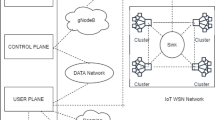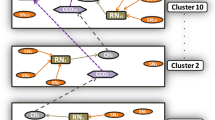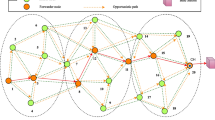Abstract
The resource constrained wireless sensor embedded devices are deployed in the edge of the Internet of Things (IoT) system for smart monitoring and control of large scale Wireless Sensor Network (WSN) applications. A joint hybrid corona based Opportunistic Routing (OR) with path-constrained Quasi-Mobile Sink (QMS) is designed to address the challenges for (i) providing long term sustainable operation and scalability of WSN (ii) also counteract the hot-spot problem near the sink. This hybrid routing design adopted opportunistic mode of forwarding as it’s first and last resort to increase transmission reliability, despite the time varying lossy radio links. The eligible relay-set based on the corona level it resides with respect to sink, collaborates for packet forwarding in a fully distributed online manner during the opportunistic mode. The priority order of relay(s) are determined on the fly based on multi-metrics fuzzy decision logic for timer based coordination and adopts a cross layered differentiated back off strategy for distributed priority based contention. The routing design switches to unicast mode of forwarding via the most trusted relay(s) for subsequent transmissions to increase the energy efficiency under stable link conditions. Simulation results shows that hybrid OR design achieves high end to end packet delivery ratio and minimizes the average energy consumed per node in comparison with existing routing protocol designs. The joint routing design with QMS is found to scale well and prevents the unbalanced energy consumption by minimizing the maximum energy dissipation and normalized energy consumption per packet compared to the Static Sink (SS) and Uncontrolled Mobility Model based Sink (UMM-S).




















Similar content being viewed by others
References
Ahmed AA (2013) An enhanced real-time routing protocol with load distribution for mobile wireless sensor networks. Comput Netw 57(6):1459–1473
Ahmed AA (2015) A comparative study of QoS performance for location based and corona based real-time routing protocol in mobile wireless sensor networks. Wirel Netw 21(3):1015–1031
Ahmed AA, Fisal N (2008) A real-time routing protocol with load distribution in wireless sensor networks. Comput Commun 31(14):3190–3203
Amirinasab M, Shamshirband S, Chronopoulos AT, Mosavi A, Nabipour N (2020) Energy-efficient method for wireless sensor networks low-power radio operation in internet of things. Electronics 9(2):320
Biswas S, Morris R (2005) ExOR: opportunistic multi-hop routing for wireless networks. ACM SIGCOMM Comput Commun Rev 35(4):133–144
Cerpa A, Wong JL, Potkonjak M, Estrin D (2005) Temporal properties of low power wireless links: modeling and implications on multi-hop routing. In: Proceedings of the 6th ACM international symposium on Mobile ad hoc networking and computing, pp 414–425
Clausen T, Yi J, Herberg U (2017) Lightweight on-demand ad hoc distance-vector routing-next generation (LOADng): protocol, extension, and applicability. Comput Netw 126:125–140
Fradj HB, Anane R, Bouallegue R (2019) Opportunistic routing protocols in wireless sensor networks. Wirel Pers Commun 104(3):921–933
Gu Y, Ren F, Ji Y, Li J (2015) The evolution of sink mobility management in wireless sensor networks: a survey. IEEE Commun Surv Tutor 18(1):507–524
Issariyakul T, Hossain E (2012) Introduction to network simulator 2 (NS2). Springer, Boston
Khan A, Abdullah A, Anisi M, Bangash J et al (2014) A comprehensive study of data collection schemes using mobile sinks in wireless sensor networks. Sensors 14(2):2510–2548
Kim J, Ravindran B (2009) Opportunistic real-time routing in multi-hop wireless sensor networks. In: Proceedings of the 2009 ACM symposium on applied computing, pp 2197–2201
Koosheshi K, Ebadi S (2019) Optimization energy consumption with multiple mobile sinks using fuzzy logic in wireless sensor networks. Wirel Netw 25(3):1215–1234
Koutsiamanis RA, Papadopoulos G, Jenschke TL, Thubert P, Montavont N (2020) Meet the PAREO functions: towards reliable and available wireless networks. In: IEEE International Conference on communications (ICC)
Lee J, Park H, Kang S, Kim KI (2015) Region-based collision avoidance beaconless geographic routing protocol in wireless sensor networks. Sensors 15(6):13222–13241
Luo J, Hubaux JP (2010) Joint sink mobility and routing to maximize the lifetime of wireless sensor networks: the case of constrained mobility. IEEE/ACM Trans Netw (TON) 18(3):871–884
Luo J, Hu J, Wu D, Li R (2014) Opportunistic routing algorithm for relay node selection in wireless sensor networks. IEEE Trans Ind Inf 11(1):112–121
Ma X, Zhang P, Theel O, Wei J (2020) Gathering data with packet-in-packet in wireless sensor networks. Comput Netw p 107124
Mainetti L, Patrono L, Vilei A (2011) Evolution of wireless sensor networks towards the internet of things: a survey. In: Proceedings of the 19th IEEE International Conference on software, telecommunications and computer networks (SoftCOM), pp 1–6
Mao X, Li XY, Song WZ, Xu P, Moaveni-Nejad K (2009) Energy efficient opportunistic routing in wireless networks. In: Proceedings of the 12th ACM International Conference on modeling, analysis and simulation of wireless and mobile systems, pp 253–260
Rahman AU, Alharby A, Hasbullah H, Almuzaini K (2016) Corona based deployment strategies in wireless sensor network: a survey. J Netw Comput Appl 64:176–193
Rivas H, Voigt T, Dunkels A (2006) A simple and efficient method to mitigate the hot spot problem in wireless sensor networks. Perform Control Wirel Sens Netw
Rosario D, Zhao Z, Santos A, Braun T, Cerqueira E (2014) A beaconless opportunistic routing based on a cross-layer approach for efficient video dissemination in mobile multimedia IoT applications. Comput Commun 45:21–31
Singh SK, Kumar P (2020) A comprehensive survey on trajectory schemes for data collection using mobile elements in wsns. J Ambient Intell Hum Comput 11(1):291–312
Tripathi J, Oliveira JCD, Vasseur JP (2014) Proactive versus reactive routing in low power and lossy networks: performance analysis and scalability improvements. Ad Hoc Netw 23:121–144
Winter T, Thubert P, Brandt A (2012) RPL: IPv6 routing protocol for low-power and lossy networks. In: Internet Eng Task Force (IETF), Request for Comments p 6550
Wu H, Wang J, Ananta RR (2018) Prediction based opportunistic routing for maritime search and rescue wireless sensor network. J Parallel Distrib Computi 111:56–64
Xie D, Wu X, Li D, Sun J (2014) Multiple mobile sinks data dissemination mechanism for large scale wireless sensor network. China Commun 11(13):1–8
Xing G, Chen Q, Wang X (2005) Real-time power control in wireless sensor networks. Washington University in St Louis, Tech Rep WUCSE-2005-31
Yue YG, He P (2018) A comprehensive survey on the reliability of mobile wireless sensor networks: taxonomy, challenges, and future directions. Inf Fusion 44:188–204
Author information
Authors and Affiliations
Corresponding author
Additional information
Publisher's Note
Springer Nature remains neutral with regard to jurisdictional claims in published maps and institutional affiliations.
Rights and permissions
About this article
Cite this article
Thyagarajan, J., Kulanthaivelu, S. A joint hybrid corona based opportunistic routing design with quasi mobile sink for IoT based wireless sensor network. J Ambient Intell Human Comput 12, 991–1009 (2021). https://doi.org/10.1007/s12652-020-02116-6
Received:
Accepted:
Published:
Issue Date:
DOI: https://doi.org/10.1007/s12652-020-02116-6




